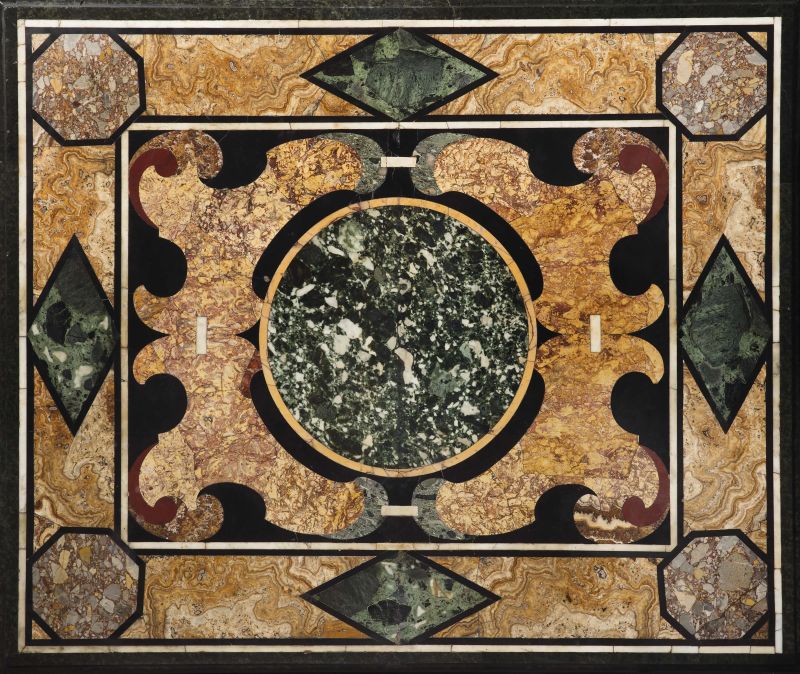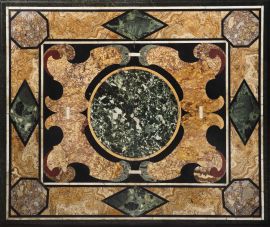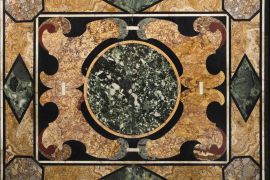Florentine manufacture, early 17th century
A TABLETOP
in polychrome stone commesso work, cm. 101 x 120.5
An export licence in available for this lot.
The tabletop decoration is composed of a tondo within a cartouche in the centre square, surrounded by a framing band marked out by alternating octagons and rhombi. The vivid polychromy of the whole is obtained exclusively through use of marbles and stones of archaeological provenance, exception made for the black ‘marble’ from Flanders used for the background of the centre portion and the outlines of the framing strip.
The centre tondo and the rhombi in the frame are in verde antico, a Greek marble in wide use in the Roman era and much valued from the Renaissance onward. In ancient times the stone was quarried in several localities in Thessaly; the different markings and tonalities that the green may assume depend on provenance. This is evident in our tabletop, in the differences we see between the four rhombi and the centre tondo, which may well have originated as a section of a column. The tondo is outlined with a strip of giallo antico marble from Numidia, while the cartouche enclosing it is largely formed of sections of Spanish broccatello, a stone which owes its notable decorative impact to the golden and purplish veins which give it the appearance of a brocade and which was in wide use in the Imperial era. The four exterior volutes of the cartouche are in a rare type of alabaster, originally from what is now Algeria, known as alabastro a pecorella, edged with rosso antico marble from the Tenaro promontory in Greece. The four internal volutes are in breccia from Egypt, whose quarries were heavily exploited by the Romans. The surrounding band is in alabastro fiorito, also of Egyptian provenance, while the four corner octagons are in breccia d’Aleppo, from the Greek island of Chios, a stone that was greatly sought-after by re-users of archaeological marbles (1)
In the past, the tabletop was divided into halves (a quite common operation, also seen, for example, in the tabletop shown in Figure 5) to obtain two console table tops from a single original slab.
The technique used for the tabletop is known as commesso: the various stone shapes composing the design, precision-cut in advance to the outlines called for by the design and then filed along their whole depth to guarantee a perfect fit, were assembled on a 5-cm ca. support slab of white marble. The stone ‘cutouts’ were then glued onto the support using an adhesive composed of wax and colophony (rosin). This technique, also known as ‘Florentine mosaic’ since it was in Florence that it was perfected and raised to extraordinarily virtuoso levels, descends from the opus sectile technique developed in ancient Rome, where from early geometric essays the artists went on to create more complex figurative compositions. The evolution of the technique in the Florence of the Medici grand dukes proceeded in an analogous manner; here, the first commesso works were aniconic but over the course of the 1600s they developed into the sophisticated ‘paintings in stone’ on naturalistic or narrative subjects created at the exclusive Galleria dei Lavori established by Ferdinando I in 1588 (2).
Initially, from the latter decades of the 1500s to the early years of the following century, the Florentine works drew their inspiration from models that had been in vogue in Rome since the mid-1500s, both for polychrome stone architectural cladding, introduced to Florence by Giovanni Antonio Dosio (1533-1611) beginning in the 1570s, and for tabletops, at length the form of interior stone furnishing most in demand. It is not always easy to identify the Florentine origin of a table with absolute certainty; with their Roman counterparts, they share employ of archaeological marbles and a taste for aniconic compositions not dissimilar to architectural stone tarsias. It is not by chance that among the earliest authors of models for tables of this type, in both Rome and Florence, we note architects such as Vignola and Dosio, several of whose designs for tabletops are conserved in the Gabinetto Disegni e Stampe of the Uffizi.
In the case of our tabletop, numerous elements suggest that it is a Florentine work, beginning with the technique, which excludes inlay in favour of commesso. Inlay, prevalent in Rome, is another ancient technique which involves chiselling the white marble backing slab to create cavities, or casse; the sections of polychrome marble are fitted into the casse and remain outlined by the strips (cigli) of the white marble of the backing left in view (Fig. 1). he presence of black marble from Flanders in the top also suggests Florence, as the city showed a precocious partiality to this material: it was chosen as the centre rectangle of one of the oldest tables in Palazzo Pitti (Fig. 2), which with our tabletop shares the inspiration offered by the architectural tarsias.
The model for the Pitti table would seem to be the geometrising rigour of Dosio’s polychrome mural works, while our tabletop denotes a more advanced taste in the elaborate centre cartouche, which echoes those by Giovanni Caccini (1556-1613) on the pillars and the arches of the ciborium in the church of Santo Spirito in Florence (Fig. 3), begun in 1599 and completed in 1608 (3). Sculptor and architect, Caccini was Dosio’s disciple and in turn contributed to spreading the taste for polychrome surfaces in Florentine architecture. The theme of the cartouche enclosed in rectangular frames returns in decoration of the Pucci chapel in the church of Santissima Annunziata (Fig. 4), begun by Caccini in 1605, as it does in the two aediculae with Saints Peter and Paul in the tribune of the same basilica, created by Caccini in the first decade of the century. Caccini was also active as a sculptor and restorer of ancient statuary, and in this role he was in close contact with Niccolò Gaddi, one of Florence’s first and most refined collectors of tables ‘of beautiful stone’ (4).
Another element that points to Florence as the origin of our tabletop is the outline band, with its distanced, symmetric geometric figures, which is structurally analogous to that of a top in pietre dure (Fig. 5), known to be Florentine, in a private collection, and that of a later top that clearly reflects the new taste for naturalistic patterns (Fig. 6), in the museum of the Opificio delle Pietre Dure.
Annamaria Giusti
Florence, 21 April 2018
1) On the origins and characteristic of breccia d’Aleppo see L. Lazzarini, ‘La scoperta dell’origine chiota della breccia d’Aleppo’ in A. Giusti (ed.), Eternità e nobiltà di materia. Itinerario artistico fra le pietre policrome (Florence, 1988), pp. 139-168. On archaeological marble in general, refer to R. Gnoli, Marmora romana (Rome, 1988); R. Borghini (ed.), Marmi antichi (Rome, 1989); C. Napoleone, Delle pietre antiche. Il trattato sui marmi romani di Faustino Corsi (Rome, 2001).
2) For the history of the grand-ducal manufactory, see A. Giusti, L’arte delle pietre dure da Firenze all’ Europa. (Florence, 2005) with bibliography of earlier literature.
3) For the altar/ciborium complex in Santo Spirito, which echoes the illustrious model of that for the Chapel of the Princes, under construction in the same years at Ferdinando I’s manufactory, see A. Giusti, Tesori di pietre dure a Firenze (Milan, 1989), pp. 51-54.
4) Agostino del Riccio writes of his contemporary Gaddi and the latter’s passion for polychrome works in stone in his Istoria delle pietre, written in Florence in 1596 and dedicated to those who delighted in ‘beautiful and useful stones’. See the edition edited by R. Gnoli (Turin, 1996).




